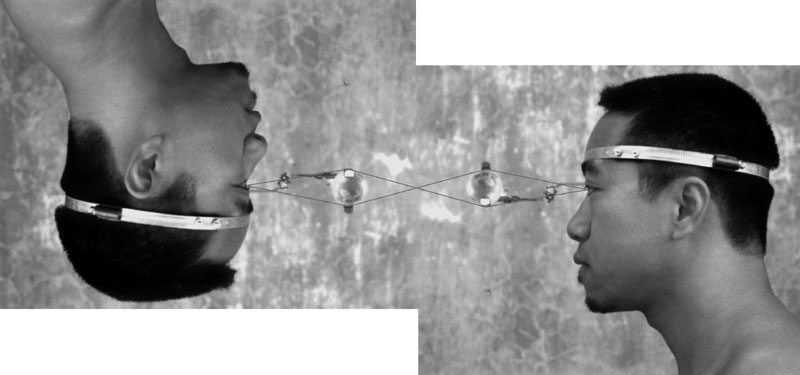Ho, Siu-kee 何 兆 基
Artworks / Writings
- About the Artist
- Aureola No.1
- Aureola No.2
- Aureola No.3
- Aureola No.4
- Aureola No.5
- Aureola No.7
- Aureola No.8
- Aureola No.9
- Aureola No.10
- Aureola No.11
- Aureola No.13
- Standing Above Water Level
- Visible Sound
- Orbiter No.1
- Orbiter No.2
- The Constrained Body
- The Third Eye
- Inner Ear
- Walking on Two Balls
- Extended Height
- Hands Up / Hands Down
- Sit / Stand / Lie
- Five Handrails
- Head Piece
- Body Cage
- Counting 1-100
- Flying Machine
- Closed System
- Per / Con-ceptual Body
- Gravity Hoop
- Body Memory
- Golden Proportion
- Golden Egg
- Self / Others
- OM
- Lotus Land
- To Melt the Frozen Lake
- Making Brick
- Article: Bodily Synthesis
- Article: Body Gesture
- Article: Perception / Conception / Expression
- Article: The World as Perceived
- Article: “Things” and “Human Beings” and “the World”
- Article: "Craftsmanship", "Bodily Synthesis" and "Art Practice"
- Artist CV
- Review by Josette Balsa
- Review by Gerard Henry
- Review by Oscar Ho
- Review by Pamela Kember
- Review by Fiona Wong
- Links
- Contact the Artist
Artwork: The Third Eye

The Third Eye
“The Third Eye” is a body sculpture piece that is put on the head. Its main component is a glass ball device attached in front of the eye. Due to the refraction of light rays, when the person looks at the world through the glass ball, the images are turned upside down. This is exactly what happens when we look at the world with our eyes. The images are refracted by the lens of the eyeball and projected upside down onto the retina. People perceive the world and construct reality through the inverted images on the retina.
By means of this bodily device, “The Third Eye” enables me to experience an unusual visual perception. However, if one wishes to turn one’s perceptual experience into an expression of art, one still has to rely on imagery, material and media as its presentation. “The Third Eye” consists of two photos, one in an upright position (positive) and the other upside down (negative), showing that when I put on the device and look at the “other”. Red lines are also applied onto the photos to explain how the light rays refract to my (two “I”s) eyeballs through the glass ball. By employing photography as the medium of representation, I can express how this device inverts the images on the retina again (become upright). This is a query on the inertia of sensory perception and the world perceived by the inertia of sensory perception. Thus, “The Third Eye” changes my personal perceptual experience to a material representation of a concept and also an expression of art.
In Phenomenology of Perception, Merleau-Ponty refers to the ‘experience of space’. He cited “Some preliminary studies on the vision of images on the retina that are not upside down”.[1] A person was required to put on a pair of spectacles that turned the images on the retina into the positive. At first, the images seen were turned upside down and looked unreal. However, after two or three days, the images were no longer perceived as turned upside down. The person felt that their body was in an abnormal position. They also had to correct their bodily movements intentionally. On the seventh day, the person was able to “see” a world that was “not turned upside down” without making any effort. The Book of Genesis in the Bible says that God completed His wonderful act of creation on the seventh day. Of course, seven days is only a coincidence. However, visual perception really can change our experience of the world. More accurately we can say that it creates a perceived world. This demonstrates the artificiality of our perception of the world.
The conception of “The Third Eye” originated from these studies quoted by Merleau-Ponty. However, the intent of the work is not to imitate a scientific experiment. Visual presentation resembling scientific experiment is only a metaphor representing the objectivity of science. It is an analogy to some of my personal views on the perceptual world and the uncertainty of the phenomenal field.
[1] Merleau-Ponty, Maurice. Phenomenology of Perception, Routledge Classic, London & New York, first published 1962, p. 285.
三眼
《三眼》是一件配戴在頭上的身體裝置,主要構成部份是一顆懸於眼睛前方的玻璃珠。由於光線折射的關係,配戴者透過玻璃珠觀看世界,景像是上下顛倒的,這正正是我們平常觀看世界時,景像透過眼球晶體折射倒映在視網膜上的相同原理。人都憑視網膜上倒罝的景觀去認識世界,並以此建構真實。
《三眼》藉身體裝置而令我獲得異於尋常的視覺感知,但個人的知覺經驗要成為藝術表達,仍需靠影像與媒介物料作為呈現。《三眼》是兩張一正一反顯示我帶上該身體裝置對望的照片,照片上再加有用以解釋光線透過玻璃珠折射到我(兩個我)眼球的紅色線。藉著攝影媒介作為呈現,表達了這裝置如何再一次顛倒視網膜上的映像,是對慣性的感知經驗;和被慣性的感知經驗所感知的世界的一種質疑。《三眼》遂由我個人的知覺經驗進而成為一種概念的物質化呈現,一種藝術的表達。
梅洛龐蒂在《知覺現象學》中提及空間的體驗,他引述了一個《關於視網膜映象不顛倒的視覺的一些初步研究》,一個被試者戴上使視網膜映像變正的眼鏡,他看到的景像最初是顛倒的,顯得不真實,但連續配戴兩、三日之後,景像開始不再顛倒,只是感到身體處於不正常的位置,亦需要有意識的努力去糾正身體動作。到了第七日,被試者已不需要任何努力就像以前那樣「看到」一個「不顛倒」的世界。聖經創世記描述上帝到第七日完成了創造世界的奇功,七日當然只是一個巧合,但視覺感知的而且確可以更新我們對世界的體驗,或者說是創造了被感知的世界。
《三眼》的構思沿自梅洛龐蒂引述的這些研究,但創作的意圖卻不在於模擬一項科學實驗。類科學的視覺呈現(代表科學的客觀性),只作為一個隱喻,喻示我個人對知覺世界的某些觀點(現象界的不確定性),而觀眾自然亦可有不同的詮釋和解讀。
